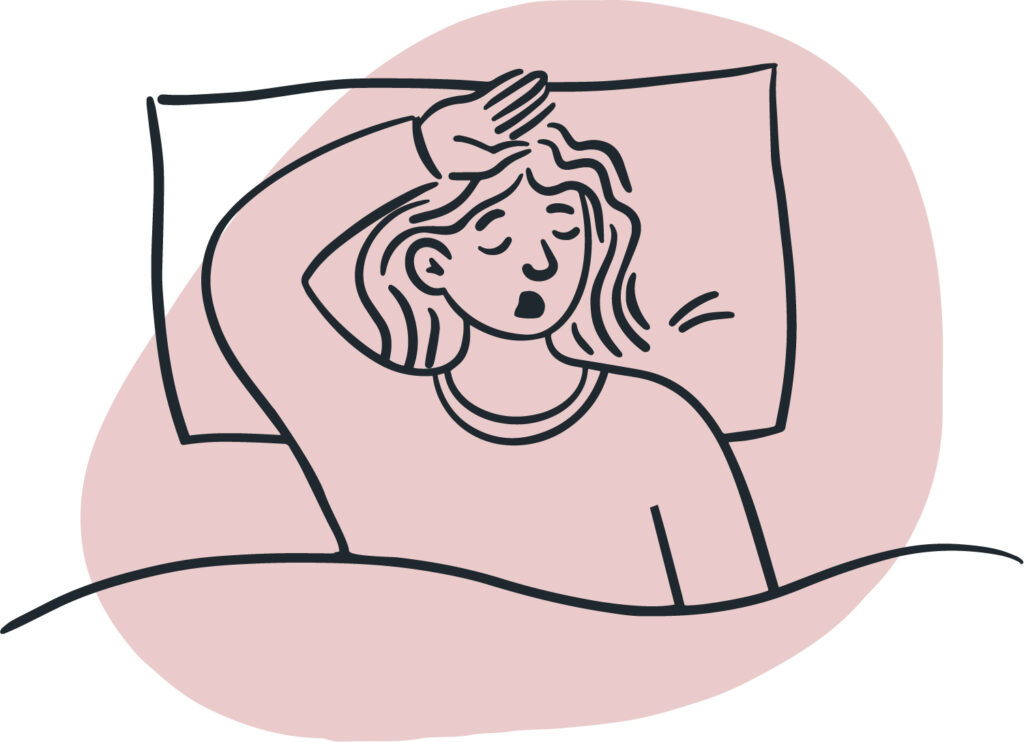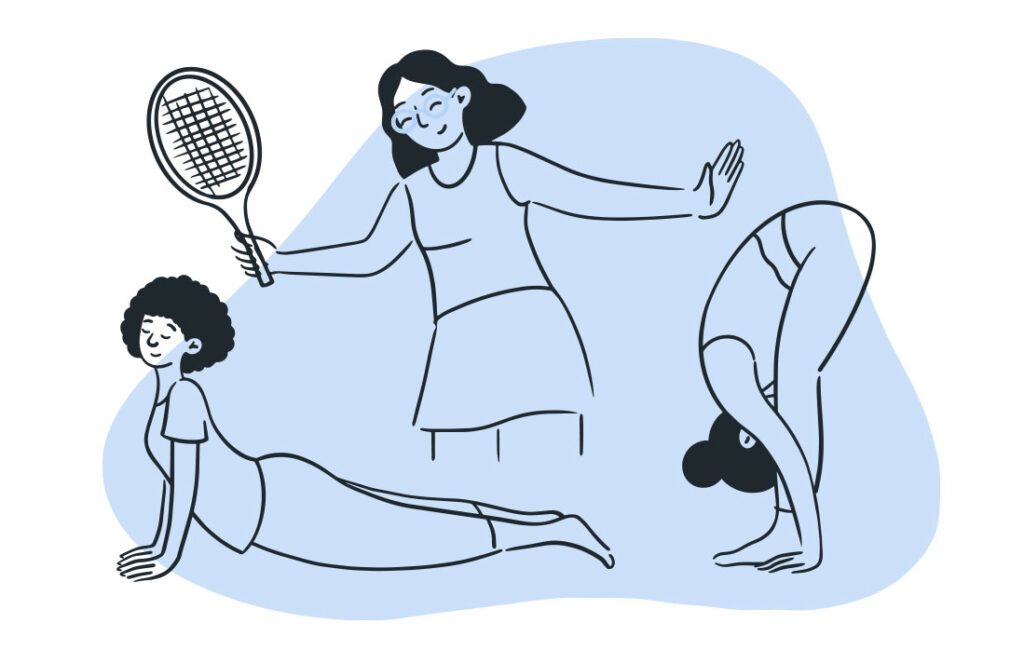Heavy Sleepers Guide
Disclosure: By clicking on the product links in this article, Mattress Nerd may receive a commission fee at no cost to you, the reader. Read full disclosure statement.
Disclaimer: In this guide, we are referring to “heavy,” “big & tall” and/or “plus-size” sleepers as those who are over 200 pounds. Our mission is to help each and every sleeper get their best night’s sleep, so we use the standard weight limits and advisories for popular mattresses to address our audience. Just the way “lightweight sleepers” (those 100 points or less) need a specific mattress and sleep considerations, so do those 200 pounds and over.
More than ever, people are beginning to embrace the shape of their bodies, thanks to an acceptance movement breaking down bias, encouraging body positivity, and improving overall self-image. However, that doesn’t mean Big & Tall people don’t have their challenges, especially when it comes to getting a good night’s sleep.
Sleep is vital to overall health and well-being. According to experts, adults need between seven and nine hours of sleep each night to feel their best. People who suffer from sleep deficit — the cumulative effect of not getting enough sleep — are at an increased risk of health problems including diabetes, weakened immune system, and high blood pressure. They can also experience mental strains like anger, depression, and forgetfulness. Research also suggests that sleep problems may contribute to weight gain by increasing appetite and impairing glucose metabolism.
Not surprisingly, studies also show that many people who are overweight or obese also suffer from some type of sleep problem. In this guide, we’ll take a closer look at some of the common sleeping problems big and tall people face, and what can be done about them.
Common Sleeping Problems for Big & Tall People
Getting Comfortable
Many people have difficulty getting comfortable at night, but it can be especially challenging for plus-sized people. Excess body weight increases pressure on joints, especially at the hips, knees, and ankles. Over time, this can cause the cartilage in these joints to wear down, resulting in pain and limited mobility.
Lying down can add more pressure on the hips or abdomen, further exasperating pain. Finding a comfortable and pain-free sleep position can mean a lot of tossing and turning, which can ultimately deprive you of much-needed sleep.
How To Get Comfortable In Bed
You may be able to find a more comfortable sleep position by sliding a pillow between your legs while lying on your side with your knees slightly bent. Look for knee pillows or full-body pillows ergonomically designed specifically for this use.
Changing mattresses may be another option, especially if you’re not fitting properly into the bed you’re in. Mattresses can aggravate existing pain or even cause new pain if they sag or don’t offer adequate support, and pain can interfere with sleep.
Heavier people will want a mattress that is supportive and comfortable. Memory foam and latex mattresses are especially good choices because they offer pressure point relief at the shoulders and hips, and keep the spine aligned — important qualities that help reduce pain. A mattress with good edge support will make it easier to get in and out of bed. Some mattresses also come infused with copper, a mineral believed to help ease joint aches and pains.
Related: The Best Mattresses for Heavy Sleepers
Overheating & Sleeping Hot
People who are overweight or obese are more likely to overheat at night and sleep hot, which can be disruptive to your sleep. That’s because body-fat tissue is a strong heat insulator that makes the distribution of heat more difficult.
A study published in the journal of The North American Menopause Society also found that older women with a higher body mass index (BMI — a measurement of body fat based on your height and weight) experience more hot flashes during menopause.
How To Stay Cool At Night
People who tend to sleep hot can generally find relief by lowering the thermostat. For most, that’s a temperature in the low- to mid-60s. A ceiling fan can also cool down your bedroom. Using lightweight, cotton bed linens and clothing can also help.
Women experiencing hot flashes related to menopause may consider natural remedies, such as ginseng or black cohosh, or prescription drugs, such as hormone therapy or low-dose antidepressants. Another way to cool down at night is with a cooling mattress which is made to help you sleep cooler. Memory foam is a popular choice but it can absorb body heat and make you hotter, but some are infused with copper, which helps pull heat away from the body. Others are infused with cooling gel which can be literally cool to the touch. Latex mattresses are also a good option because they contain holes that allow air to pass through, which makes them naturally cooler.
Snoring
There is a direct link between snoring and being overweight. Snoring may not be as disruptive to the person snoring as much as it is to the person they’re sleeping with. But beware: Snoring can become louder over time and lead to sleep-breathing disorders, like sleep apnea.
Fat’s link to snoring depends on where on your body fat settles. According to the snore specialists at the SnoreLab, neck fat compresses the airway when you are lying down, which triggers snoring. The fat that settles on your belly pushes up on the diaphragm whereas fat on your chest compresses the ribcage. Both of these issues can inhibit the lung’s capacity and restrict breathing, which causes snoring.
This fat distribution theory also explains why pregnant women are more apt to snore. It also explains why men tend to snore more than women — men gain the proverbial “beer belly” whereas women generally gain weight on the thighs, hips, and butt. However, when women hit menopause, their fat redistributes which can cause them to snore, too.
Is It Possible To Stop Snoring?
How does one stop snoring? There are various gadgets you can try from nasal strips to anti-snoring devices. Some sleep doctors may recommend surgery or a CPAP pressurized air mask often used to treat sleep apnea. But you may first want to try some of these more natural options:
- Limiting or avoiding alcohol before bedtime. Alcohol can relax the muscles in your throat and make you more prone to snoring.
- Losing weight. Even a small weight loss can reduce the pressure fat puts on your neck, chest, or belly.
- Changing sleep positions. People tend to snore more when they’re lying on their backs because their tongues drop to the back of their throats and can obstruct airflow. Rolling over onto your side may help open the airways.
- Raising the head of your bed. Using wedges under your mattress or an adjustable bed frame to raise your head about four inches can help open airways and quiet your snoring.

Sleep Apnea
More than 18 million adults in America suffer from sleep apnea, also called obstructive sleep apnea. One major risk factor is weight gain. Similar to snoring, sleep apnea occurs when your tongue falls to the back of your throat and blocks your windpipe. The difference is that with obstructive sleep apnea, snoring is accompanied by moments of pauses during which you stop breathing because your airway has collapsed. This causes you to choke, cough, or gasp, and wake you repeatedly during the night.
Sleep apnea can be dangerous, causing low blood oxygen, which can lead to high blood pressure and heart disease — conditions for which overweight and obese people are already at high risk.
Sleeping with Sleep Apnea
Elevating the head of the bed with a wedge under the mattress or with an adjustable bed frame may help reduce episodes of sleep apnea. For more frequent or severe cases of sleep apnea, it’s best to consult with a doctor or sleep specialist. Doctors often prescribe devices like CPAP for the treatment of sleep apnea. A CPAP machine increases air pressure in your throat to prevent your airway from collapsing when you breathe in during sleep. CPAP masks can be bulky and uncomfortable, but many users get used to them in time. See: Best Mattresses for Adjustable Bed Frames
A more practical and less invasive way to treat sleep apnea is by losing weight. Studies show that many people saw as much as a 50% improvement in sleep apnea by losing just 10-15% of their body weight. People who lost as much as 60% of their body fat saw their sleep apnea episodes disappear completely.
Acid Reflux
People who are overweight or obese are more likely to suffer from acid reflux, a condition in which acid flows back up into the esophagus causing irritation, inflammation, and heartburn pain. According to the nonprofit Obesity Action Coalition, plus-sized people are prone to acid reflux either because excess belly fat puts pressure on the stomach, a hiatal hernia is causing acid to flow back up the esophagus, or hormonal changes cause an overproduction of acid.
Acid reflux is more serious than just occasional heartburn. Over time, the acid can cause complications such as narrowing of the esophagus, which can cause problems swallowing; the development of sores or ulcers, which can bleed, become painful, or make swallowing difficult; or lead to a condition called Barrett’s esophagus, a precursor to esophageal cancer.
Acid reflux can happen any time of the day, but often rears its ugly head at night and interferes with your sleep.
Managing Acid Reflux
Attacks of acid reflux can be reduced with lifestyle modifications such as limiting alcohol, carbonated beverages, caffeine, cooked tomato sauces, spicy foods, and high-fat foods. Over-the-counter or prescription acid-reducing medications can also offer some relief. It may also help to raise the head of your bed either with wedges under the mattress or with an adjustable bed frame, which relies on gravity to help acid flow back down the esophagus.
Perhaps the best way to reduce acid reflux is to lose weight. According to a study published in the journal Obesity, overweight individuals who enrolled in a structured weight-loss program involving a healthy diet and physical activity experienced fewer episodes of acid reflux. In fact, the more weight they lost, the more their symptoms improved.
Obesity Hypoventilation Syndrome
Obesity hypoventilation syndrome (OHS) is a serious but treatable breathing problem in obese people that leads to low oxygen levels and too much carbon dioxide in the blood. The three main characteristics of OHS are obesity, daytime hypoventilation (this moving insufficient air in and out of your lungs), and disordered breathing during sleep (such as with obstructive sleep apnea).
Symptoms of OHS include daytime sleepiness, lack of energy, breathlessness, headache, and depression. Nighttime symptoms include loud and frequent snoring and sleep apnea. If left untreated, OHS can be life-threatening.
Can You Treat OHS?
People who suffer from OHS should talk with a medical professional. Treatment generally includes weight loss along with therapy to address your sleep disorder. A sleep study may be ordered and other therapy prescribed, such as a CPAP (continuous positive airway pressure) or BPAP (bi-level positive airway pressure). In rare cases, a tracheostomy may be needed to adequately treat low oxygen caused by OHS. Researchers are investigating medications for the treatment of OHS, but at this point, none are approved for this use.
Restless Leg Syndrome
Restless leg syndrome, often called RLS or Willis-Ekbom Disease, is an unpleasant sensation that causes an irresistible urge to move the legs. RLS typically occurs in the evening hours and is often more severe at night when you’re trying to sleep. The symptoms are usually described as itching, crawling, pulling, aching, throbbing, or pins and needles sensation.
Unfortunately, obese adults — especially obese women — are at greater risk of RLS. A study published in Neurology, the medical journal of the American Academy of Neurology, found that men and women with a BMI higher than 30 were almost one-and-a-half times more likely to suffer from RLS compared to people who were not obese. The reason is likely because heavier people have lower dopamine receptor levels in the brain. Dopamine is a chemical naturally produced by the body that transmits signals between nerve cells.
About 80% of RLS suffers also experience a condition known as PMLS, short for periodic limb movement of sleep, during which a person involuntarily twitches or jerks their legs or arms every 15 to 40 seconds during sleep. For some people with PMLS, these movements continue throughout the night, which can obviously interfere with a good night’s sleep.
Getting A Good Night’s Sleep with RLS
Walking around generally helps relieve symptoms of RLS. But this is not always practical or long-lasting. Some home remedies that may help ease RLS discomfort include baths and massages, warm or cool packs, exercise, and avoiding caffeine.
Medications used to treat RLS include a class of drugs called dopamine agonists, medications like gabapentin that treat nerve pain, opioid painkillers, muscle relaxers, and sleeping pills.
Sleep-Related Eating Disorder
Sleep-related eating disorder (SRED) is a type of sleep disorder during which people eat while they are asleep. For example, people with SRED may sleepwalk into the kitchen and prepare a meal and eat it without remembering or even realizing they did it. During spells of SRED, they may consume foods they don’t usually eat during the day, and may even eat inedible objects or strange combinations of food. People with SRED often develop problems such as:
- Weight gain
- Metabolic conditions such as diabetes or high cholesterol
- Injuries from preparing food, such as lacerations or burns
- Cavities from consuming sugary foods
- Illness from undercooked foods or eating toxic substances
Nocturnal eating syndrome (NES) is a close cousin of SRED. This occurs when someone eats during the night fully aware of what they are doing. These individuals cannot fall to sleep unless they eat. NES is typically diagnosed if nocturnal eating persists for at least two months.
How To Combat SRED
Treatment for SRED and NES generally involves an evaluation with a sleep specialist. Medications such as antidepressants and melatonin and therapies such as cognitive-behavioral therapy or relaxation training may help sufferers as well.

Sleep & Fitness
The benefits of regular exercise are well-documented. Exercise can help you lose weight, improve your cardiovascular health, and improve your mood. It can also help you sleep better at night and help you feel more refreshed and alert the next morning.
Exercise can also help you fall asleep and stay asleep. In fact, engaging in at least 30 minutes of moderate aerobic exercise, such as taking a brisk walk or participating in an active yoga class, can improve sleep that very night.
Getting into a regular fitness routine can also help reduce or eliminate sleep disorders, according to a study published in the journal Nature and Science of Sleep. This can improve quality of life as well as decrease risk for chronic conditions generally associated with obesity.
According to experts, morning or afternoon is the best time to exercise in order to enjoy the benefits of better sleep. Morning workouts help with longer and deeper sleep whereas afternoon workouts help you fall asleep faster.
Sleep & Weight Loss
Losing weight is key to improving your sleep. But sleep is also an important part of successful weight loss.
Studies suggest that people with inadequate sleep experience negative changes in metabolism. For example, an adult who sleeps just four hours a night appears to be hungrier and have more appetite — particularly for calorie-dense foods high in carbohydrates — compared to someone who gets 10 hours of sleep a night. One explanation is that the length of time you sleep affects ghrelin and leptin, hormones that regulate hunger.
Another way poor sleep can impede weight loss is that restricted sleep zaps your energy. It’s difficult to get in the mood for exercise when you’re exhausted.
A healthy diet is also important for weight loss. But diets that are too restrictive may leave you starving at bedtime. Hunger pangs will not only interfere with your sleep, they also slow your body’s ability to convert proteins into muscle. Be sure you are eating enough healthy meals throughout the day that your body can draw energy from fats at night. And, avoid heavy meals before bedtime to ensure a good night’s sleep.
General Sleep Tips for Big & Tall People
There are several ways you can lose weight and improve your sleep:
Eat Smarter
- Avoid fast food.
- Avoid foods high in carbohydrates and fat.
- Choose lean meats such as fish and chicken.
- Eat more fresh fruits and vegetables.
- Avoid heavy meals before bedtime.
- Consult with a nutritionist.
Exercise Regularly
- Try moderate exercise, such as brisk walking or active yoga, for at least 30 minutes, five times a week.
- Schedule exercises in the morning or afternoon.
- Avoid exercising less than three hours before bedtime, as it may be difficult for your body to come down from mood-enhancing endorphins released during exercise.
Examine Your Sleep Schedule
- Establish a regular bedtime and wake time.
- If you get up in the mornings feeling lethargic, you may need to increase the amount of sleep you get at night. Most adults need seven to nine hours of sleep nightly.
- If you suspect you suffer from a sleep disorder, make an appointment with a doctor or a sleep specialist.

Sleep Accessories for Plus Size People
Some bedding products and accessories can help make you more comfortable for a better night’s sleep:
Mattress Features
- Support – Heavier people need a mattress that is sturdy enough to support their weight and durable enough to last a while. Conventional mattresses can accommodate people up to 250 pounds each with a 500-pound weight limit on beds designed for two. Some mattresses are specially designed to support up to 1,000 pounds. There are many mattresses made specifically for heavier people, that provide adequate support and comfort.
- Firmness – A medium-firm to the firm mattress should provide good support for heavier people. A too-soft mattress may make you sink in too far and make moving or getting out of bed more difficult.
- Pressure point relief – Current-day mattresses are made with comfort in mind, and that includes enough give to alleviate pressure points at the shoulders and hips. This is especially important for heavier people who are more likely to suffer from chronic aches and pains.
- Spine alignment – Mattresses that keep the spine aligned when you’re lying on your side help reduce back pain.
- Motion isolation – Mattresses that isolate motion can keep you from waking your bed partner when you roll over or get out of bed.
- Temperature regulation – People who are overweight and menopausal women tend to sleep hotter or suffer from night sweats. Naturally cooling latex mattresses or mattresses infused with heat-dispersing copper or cooling gel can help keep you cool at night.
- Edge support – Support along the edge of the bed not only helps to keep you secure in bed if you tend to sleep close to the edge, it also provides enough support to help you to climb in and out of bed.
Mattress Types
- Innerspring – Traditional mattresses are made with steel coil construction and have more bounce than beds without innerspring. These beds generally offer less pressure point relief and spine alignment.
- Foam – Memory foam is known for its responsiveness, contouring, and comfort. Beds made with memory foam usually provide good pressure relief, spine alignment, and motion isolation. But they can run hot if not infused with cooling gels or minerals.
- Latex – Latex beds are less contouring than memory foam but offer similar pressure relief, spine alignment, and motion isolation. They’re also made with small holes which help with airflow and, as a result, are naturally cooling.
- Hybrid – Hybrid mattresses offer a combination of two different mattress materials, typically innerspring and a thicker layer of foam.
Pillows
- Body pillow – Body pillows are long, narrow pillows that are designed to lay along your body and between your legs as you lie on your side. These pillows can help improve spine alignment to alleviate back or hip pain.
- Knee pillow – Knee pillows are shorter versions of body pillows. They are designed to fit comfortably between your knees while you lie on your side to help with back and sciatica pain.
- Wedge pillow – Wedge pillows are triangle-shaped, tapered pillows made of moderately firm foam designed to keep your head elevated at night to reduce snoring and relieve acid reflux and sleep apnea.
- Cooling pillow – Hot sleepers may appreciate a cooling pillow made from gel-infused memory foam or latex.
Bed Frames
- Heavy-duty frames – Heavier people will want to look for a heavy-duty bed frame that can accommodate their weight, the weight of their bed partner, and the weight of the mattress. Some heavy-duty metal and steel bed frames have a capacity of 2,000 pounds or more.
- Adjustable frames – Adjustable beds allow you to raise the head and/or feet of the mattress. This can provide comfort while reading, watching TV, or sleeping. Elevating the head about four inches at night can help reduce snoring and help relieve sleep apnea or acid reflux attacks.
Final Thoughts
Everyone deserves the benefits that come with a good night’s sleep, whether you love the body you’re in or are embarking on a weight loss journey. But if you are overweight, you may experience more sleep problems than an average-weight person. Consider losing weight to improve your sleep. Or, seek out solutions to problems that affect your sleep.
After all, sleeping well and waking refreshed improves your overall health and wellbeing, and better equips you to tackle the day ahead.
Heavy Sleepers Guide FAQs
What weight is considered a heavy sleeper?
Mattress companies classify heavy sleepers as being over 230 lbs. If you fall into this category, there are a few specific features to look for in a mattress for heavy sleepers.
What size bed should a person over 6 feet tall have?
If you are over 6 feet tall, you should consider a mattress with a length of at least 80 inches. These parameters include a Twin XL, Full XL, Queen, King, or a California King mattress.
Check out our mattress size guide to learn more.


